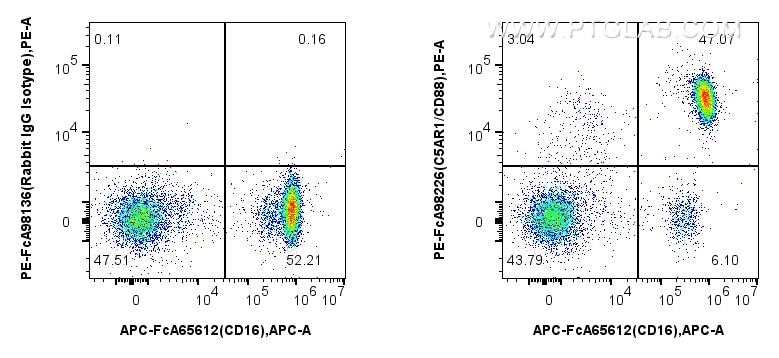Tested Applications
| Positive FC detected in | human peripheral blood leukocytes |
Recommended dilution
| Application | Dilution |
|---|---|
| Flow Cytometry (FC) | FC : 5 ul per 10^6 cells in 100 μl suspension |
| This reagent has been pre-titrated and tested for flow cytometric analysis. The suggested use of this reagent is 5 ul per 10^6 cells in a 100 µl suspension or 5 ul per 100 µl of whole blood. | |
| Sample-dependent, Check data in validation data gallery. | |
Product Information
PE-FcA98226 targets C5AR1/CD88 in FC applications and shows reactivity with human samples.
| Tested Reactivity | human |
| Host / Isotype | Rabbit / IgG |
| Class | Recombinant |
| Type | Antibody |
| Immunogen | Recombinant protein Predict reactive species |
| Full Name | complement component 5a receptor 1 |
| Calculated Molecular Weight | 39kDa |
| GenBank Accession Number | NM_001736.4 |
| Gene Symbol | C5aR |
| Gene ID (NCBI) | 728 |
| Conjugate | PE Fluorescent Dye |
| Excitation/Emission Maxima Wavelengths | 496 nm, 565 nm / 578 nm |
| Form | Liquid |
| Purification Method | Protein A purification |
| UNIPROT ID | P21730 |
| Storage Buffer | PBS with 0.09% sodium azide and 0.5% BSA, pH 7.3. |
| Storage Conditions | Store at 2-8°C. Avoid exposure to light. Stable for one year after shipment. |
Background Information
C5aR, also named CD88, is a G protein-coupled receptor for the anaphylatoxin C5a, a cleavage product of the complement cascade. The C5a ligand is a proinflammatory component of host defense. C5aR is activated upon binding of the C5a molecule. Receptor activation stimulates chemotaxis, granule enzyme release, intracellular calcium release, and superoxide anion production.
Protocols
| Product Specific Protocols | |
|---|---|
| FC protocol for PE C5AR1/CD88 antibody PE-FcA98226 | Download protocol |
| Standard Protocols | |
|---|---|
| Click here to view our Standard Protocols |



